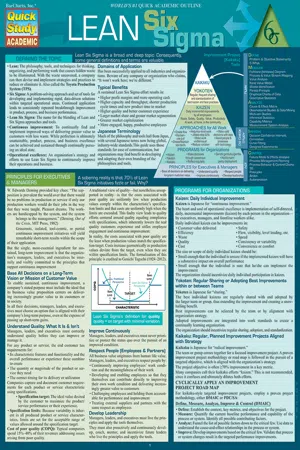
- 44 pages
- English
- ePUB (mobile friendly)
- Available on iOS & Android
Lean Six Sigma - Quick Study
About This Book
Whether curious as to how Lean Six Sigma works, in training for certification or a very experienced champion, everyone will find this tool essential as the ultimate quick reference guide to the combined process improvement methods of Lean and Six Sigma. This amazingly thorough 6-page laminated guide was developed by Craig Gygi, best-selling author, trainer, consultant, and internationally recognized leader in operational excellence. Color-coded sections, diagrams, examples, definitions, equations, flow of the process and tools for improvement are organized and designed for ease of reading and referencing at a moments notice. See for yourself, and then order a set for your team or organization. Suggested uses:
• Introduction – curious about Lean Six Sigma as a certification or for implementation within your business
• Training Tool – certification for yourself, your company or your team
• Expert or Practitioner – as a handy reference to core principles or tools like charts and equations, but also as a giveaway to colleagues who need some support
• Team – make this your company crib sheet
Frequently asked questions
Information

- The key metric used to describe the magnitude of the problem
- If possible, an estimate of the hard and soft financial impact the problem is causing
- Where in the work process or organization the problem is occurring
- The period of time over which the problem has been occurring
- An improvement goal for the key metric
- A specific target date for completion of the project
- An estimate of the financial value generated or savings (including intangible savings) accumulated by reaching the objective
| VISIBLE SYMPTOMS/ UNDERLYING CAUSES | CORRESPONDING LEVEL OF SOLUTION | IMPROVEMENT DURATION | |
| Why?↓ | Order is not ready to ship on time | Expedite the shipment | Short term |
| Why?↓ | Production work went slower than expected | Add more production staff | Short term |
| Why?↓ | Raw materials were more difficult than usual to handle | Refresh material handling training | Short term |
| Why?↓ | Bad raw materials were approved for use due to low stock levels | Increase stock levels for raw materials | Short term |
| Why?↓ | Raw material purchases are not well planned | Improve raw material order planning | Short term |
| Why?↓ | Management hasn’t allowed time for purchase planning system improvements | Initiate purchase planning improvement projects | Short term |
| Purchasing management is not fully committed to continuous improvement | Coach and mentor purchasing management in principles and benefits of continuous improvement | Long term |

- Place a statement of the problem or symptom at the head of the fish.
- Draw a backbone to the fish with six main “branches,” labeled as follows: man, machine, method, materials, measurement, and environment.
- Use these categories as prompts to thoroughly consider and identify all possible input factors. Record identified factors on the fishbone diagram.
- Do not be overly critical of ideas while gathering factors, as this will stifle creativity.
- Later, the identified factors can be prioritized by the strength or likelihood of their impact on the...
Table of contents
- DEFINING THE TOPIC
- PRINCIPLES FOR EXECUTIVES & MANAGERS
- PROGRAMS FOR ORGANIZATIONS
- APPROACHES FOR ALL WORK
- TOOLS FOR IMPROVEMENT
- ROLES, RESPONSIBILITIES & CERTIFICATIONS